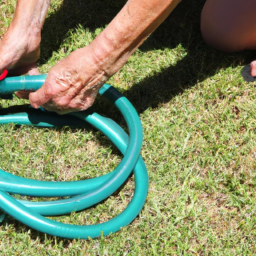How To Patch A Garden Hose
How To Patch A Garden Hose
Introduction
A garden without a garden hose is like a car without wheels. Mastering how to patch a garden hose isn't as intimidating as it may sounds. The goal is to get your garden hose working in the most efficient and longest-lasting way possible. Like with any garden tool, there are several considerations to take into account before making a purchase.
How To Patch A Garden Hose
Types of Hose Repair Patches
The first step is to identify the kind of repair patch you need. There are three main types of repair patches: rubber repair patches, metal patches, and adhesive patches. Each type has its own pros and cons. Rubber repair patches are known to be one of the most reliable and economical patches available. They are also resistant to temperature changes and are easy to apply. Metal patches are more expensive than rubber but offer superior durability. They are also the preferred patch for high-pressure hoses. Lastly, adhesive patches are not ideal for use in low-pressure hoses but are great for sealing small pinholes.
When To Use A Hose Patch
It is important to determine when a hose patch is necessary. If your hose has any small cracks, pinholes, or openings, a patch may be required to prevent water from leaking. However, for larger cracks or split hoses, a different type of repair is needed. It is also essential to inspect your garden hose frequently for cracks or splitting so that you can take action before an expensive repair or replacement is needed.
How To Apply A Hose Patch
Once you have chosen the right type of hose patch for your garden hose, it is important to take the proper steps to apply the patch. The exact steps to follow vary depending on the kind of patch you choose, but all involve cleaning and drying the hose before applying the patch. This ensures that the patch is securely fastened.
Hose Patch Equipment
In addition to a patch, you may need to purchase some additional equipment to get the repair job done. Essential tools such as a wrench, wire cutters, and pliers might be needed to properly attach the patch. It's also sensible to have a pair of protective gloves on hand.
Increase The Life Of Your Hose
Another tip to keep in mind is to properly store and care for your garden hose. Always coil the hose neatly when not in use and keep it out of direct sunlight to prolong its lifespan. Periodically, inspect your hose for small cracks or pinholes and use a repair patch if necessary.
In Summary
Patches are an excellent way to extend the life of your garden hose. There are three main types of repair patches: rubber, metal, and adhesive. Take the time to watch for small cracks, as they can quickly grow and lead to costly repairs or replacements. It is also important to properly store and care for your garden hose. With the right equipment and technique, you can make sure your garden hose is in tip-top shape for years to come.

Previous Page
Next Page
